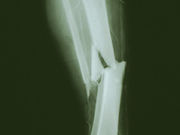Reduced fracture risk for surgery; bisphosphonate treatment no better than observation
WEDNESDAY, April 6, 2016 (HealthDay News) — For patients with primary hyperparathyroidism (PHPT), parathyroidectomy is associated with reduced fracture risk, whereas bisphosphonate treatment is not superior to observation, according to a study published online April 5 in the Annals of Internal Medicine.
Michael W. Yeh, M.D., from the UCLA David Geffen School of Medicine and Kaiser Permanente Los Angeles Medical Center, and colleagues examined the comparative effectiveness of surgical and medical treatments on fracture risk in PHPT in a retrospective cohort study conducted from 1995 to 2010.
The researchers found that observation led to a progressive decrease in total hip bone mineral density (BMD) in 2,013 women and men with serial bone density examinations. Transient increases in total hip BMD were observed with parathyroidectomy and bisphosphonates in women. In 6,272 patients followed for fracture, at 10 years the absolute risk for hip fracture was 55.9 events per 1,000 patients among those undergoing observation, 20.4 events per 1,000 patients among those undergoing parathyroidectomy, and 85.6 events per 1,000 patients among those treated with bisphosphonates. At 10 years the risk for any fracture was 206.1, 156.8, and 302.5 events per 1,000 patients among those undergoing observation, parathyroidectomy, and bisphosphonate treatment, respectively. Parathyroidectomy correlated with reduced fracture risk in osteoporotic and osteopenic patients, while increased fracture risk was seen with use of bisphosphonates in these populations.
“Parathyroidectomy was associated with reduced fracture risk in patients with PHPT, whereas bisphosphonate treatment was not superior to observation,” the authors write.
One author disclosed financial ties to the pharmaceutical industry.
Full Text (subscription or payment may be required)
Copyright © 2016 HealthDay. All rights reserved.








